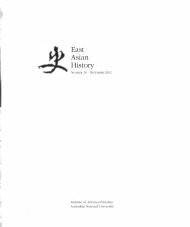Portrait of a Tokugawa Outcaste Community ... - East Asian History
Portrait of a Tokugawa Outcaste Community ... - East Asian History
Portrait of a Tokugawa Outcaste Community ... - East Asian History
Create successful ePaper yourself
Turn your PDF publications into a flip-book with our unique Google optimized e-Paper software.
92TIMOTHY D. AMOS26 Tsukada, Mihunsei shakai to shiminshakai: kinsei nihon no shakai to hO,pp.248--49.27 Koyanagi-ke monio [Documents <strong>of</strong> theHouse <strong>of</strong> Koyanagil (Higashi MatsuyamaToshokan). An index <strong>of</strong> the Koyanagi-kemonio can be found at the Higashi MatsuyamaMunicipal Library. A micr<strong>of</strong>ilm version<strong>of</strong> the entire collection <strong>of</strong> the documents isalso in the possession <strong>of</strong> the author. Hereafter,documents from this collection arecited as KKM, #_.28 Higashi matsuyama-shi hensanka,"Shomibun to yaku" [Various Statusesand Duties], in Higashi matsuyama norekishi [<strong>History</strong> <strong>of</strong> Higashi Matsuyama1, ed.Higashi matsuyama-shi hensanka 2(Higashi Matsuyama: Higashi matsuyamashi,1985), pp.l65-78.29 SDKK, ed., Suzuki-ke monio, VoU, 591[6551.30 SDKK, ed., Suzuki-ke monio, VoLl, 209[12281. For another account <strong>of</strong> this incidentsee SKM, #169.eta begging rights be given away to hinin who would be employed andmade to work in the hinin hut. Hinin were made to perform the aforementionedduties <strong>of</strong> carcass disposal (bayaku :l:fji:) in exchange forreceiving the right to beg alms. 2 6The workplaces <strong>of</strong> Matsuyama M LlJ village and Lower Wana villagewere located alongside each other. The villages, in spite <strong>of</strong> their closeproximity, were located in different counties. Lower Wana village waslocated in Yokomi, and Matsuyama village in Hiki ltlt county. The workplaceboundaries, however, did not follow traditional landholding patternsbased on warrior domains, but cut through both Yo komi and Hiki countydivisions. And although members <strong>of</strong> these two villages would rarelydeal directly in the everyday business <strong>of</strong> flaying, tanning, and producingmerchandise through secondary industrial activity or cottage industries,close relationships were forged that predictably resulted in both positiveand negative experiences for the members <strong>of</strong> both communities.Some <strong>of</strong> the history <strong>of</strong> the eta settlement in Matsuyama village maybe found in the The Documents <strong>of</strong> the House <strong>of</strong> Koyanagi (Koyanagi-kemonjo /N:YPC:iI) authored by the local eta village head in Matsuyama. 27According to the town history <strong>of</strong> Higashi Matsuyama *r LlJ, Matsuyamavillage was a postal town along the J6sM -.l1+1 and Chichibu )( roadsthat formed during the Sengoku period. It was a point <strong>of</strong> intersection forthe various workplaces <strong>of</strong> Oka [;ll], Matsuyama, Karako T, and Honshuku*m. The map <strong>of</strong> the Matsuyama workplace, dated 1830, informs usthat it was predominantly based in Matsuyama township, but also includedparts <strong>of</strong> Yo komi county. One major difference between the workplaces <strong>of</strong>Lower Wana village and Matsuyama village was the fact that the workplace<strong>of</strong> Matsuyama village was not only a space for eta and hinin, but was alsoa "begging ground" (kanjinba ifJ:l:) for a variety <strong>of</strong> other marginalized<strong>Tokugawa</strong> groups including oshi 1ftflgjjj (low-ranking shrine attendants),shugen {I (hermit ascetics), kanjin hijiri ifJ (mendicant lay priests),zat6 (blind performers/acupuncturists), goze tf (blind femaleperformers), and onmy6ji gjjj (lay diviners). In other aspects related toeta-hinin relations, taxation, land ownership and the like, there appearsto be little difference between the eta and hinin communities <strong>of</strong> LowerWana and Matsuyama villages. 28The record <strong>of</strong> the first encounter between Lower Wana village andMatsuyama village in 1699 is actually a dispute over the territorial boundaries<strong>of</strong> the workplace. 29 A hinin called Sajibe {;t[)XWJ allegedlyprocured a dead animal carcass from a village "dumping ground" Csutebaf&:l:) that lay near the border <strong>of</strong> the two separate workplaces <strong>of</strong> Wanaand Matsuyama. He was subsequently captured and incarcerated byMatsuyama villagers for his action. The village elders from Lower Wanathen attempted to negotiate a boundary between the two workplaces,but when negotiations broke down, they appealed to the magistrate. Asa result, the authorities ruled in favour <strong>of</strong> Lower Wana village. 3 0
















